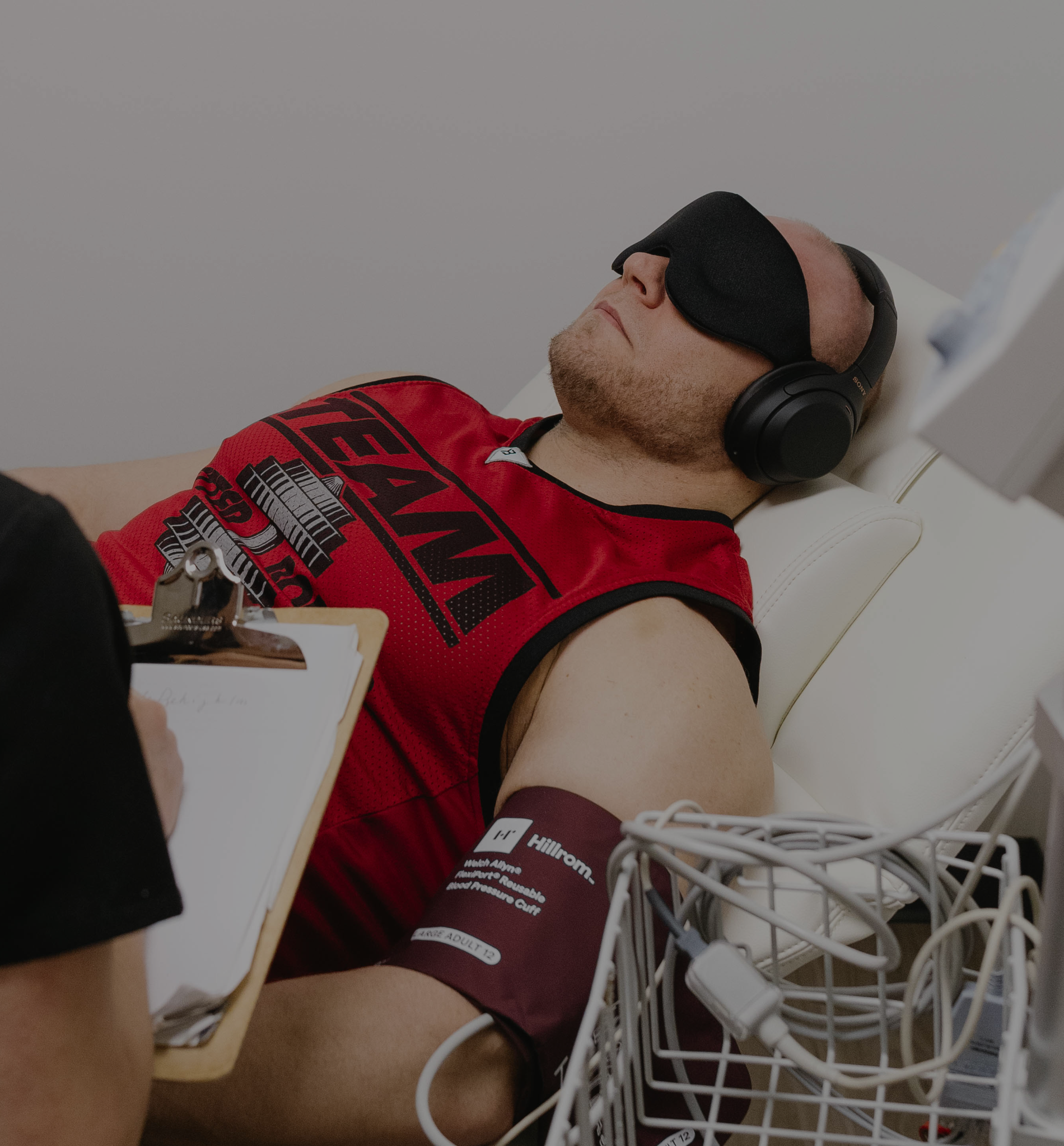Ketamine IV Infusion
Take control of your happiness with Ketamine Therapy.
Patient-centered IV Infusion ketamine-assisted experiences for anxiety, depression, PTSD, stress, and more.


FDA Approved medication
What is Ketamine?
- Users experience results in the first treatment 85%
Ketamine is a medication that has been approved by the FDA as an anesthetic for decades. In the late 80’s-90’s, it gained notoriety as a recreational drug called “special K.” However, in the late 90s, scientists uncovered the role of the neurotransmitter glutamate in neuroplasticity, the brain’s capacity to develop healthy new neuronal circuits. Glutamate, an amino acid, serves as a means of communication among neurons in the brain. Given ketamine’s modulation of glutamate receptors, research delved into its potential effects on mental health conditions
Am I a Canidate
Conditions treated with Ketamine
IV Therapy & Spravato

Depression
Treatment-resistant depression (TRD) is a common occurrence in clinical practice, with up to 60% of patients not achieving adequate response following antidepressant treatment.

Chronic Stress
Chronic stress can cause a range of physical and mental health issues. The vast majority of Americans report feeling stressed weekly, at an alarming growing rate.

Anxiety
The most common mental illness affecting 40 million adults age 18 and older. Anxiety disorders are highly treatable, yet only 36.9% of those suffering receive treatment.

Mood Disorders
Nearly 10% of adults will experience a mood disorder every year. Of the individuals who do have a mood disorder, 45% of them experience severe symptoms.

PTSD
At some point in their lives, 7-8% of the population will experience post-traumatic stress disorder or PTSD. About 8 million adults have PTSD during a given year.

OCD
25 million adults, or approximately 1.2% of the population, are affected by obsessive-compulsive disorder. Women are 3x more likely to be affected than men.

Rooted in Science
How does ketamine work?
Continue reading
These key regions include the prefrontal cortex, the hippocampus, and amygdala, and the limbic system. The atrophy observed in these crucial brain areas makes it difficult to alter one’s thoughts and emotions, potentially exacerbating or causing mental health deterioration.
When ketamine is introduced to the brain, it swiftly boosts glutamate transmission, leading to increased production of BDNF (brain-derived neurotrophic factor). BDNF, a protein essential for promoting the growth, maintenance, and survival of neurons, as well as enhancing neuroplasticity, plays a crucial role in the brain’s ability to adapt and change. In essence, ketamine acts as a signal to the brain, prompting the growth of new neurons and fostering healthier connections. By rapidly enhancing neuroplasticity at both the cellular and functional levels of the brain, ketamine can effectively alter how individuals perceive and interpret life experiences.
Conventional antidepressants like SSRIs and SNRIs primarily target neurotransmitters such as serotonin, norepinephrine, and dopamine in the brain. However, these medications often require 3 to 8 weeks before results are noticeable. While around 30% of individuals experience benefits from the drug’s effects, another 30 to 40% may experience improvement due to the placebo effect or spontaneous recovery. Nonetheless, approximately 35 to 40% of people do not see significant results from traditional antidepressant treatments. Ketamine can swiftly alleviate symptoms of depression, often noticeable within 24 hours of treatment. Clinical evidence suggests that an initial “induction” series of 6 treatments is typically required to maintain the improvement in symptoms over time. Following this, patients may require intermittent booster infusions as needed.
When depression stems from typical reactions to challenging life events or negative self-talk, medication alone is unlikely to resolve these underlying issues. Ketamine has the potential to provide the brain with a boost, enabling it to resume functioning and approach problems from a new perspective. Clinical findings suggest promising effectiveness rates ranging from 70 to 85% for individuals experiencing severe depression, PTSD, and anxiety.



Why IV ketamine treatment?
At Re-Gen Aesthetics Concierge, we perform IV ketamine infusions as they are the most controlled and can achieve the greatest results.


IV ketamine infusions are more common because, through this delivery method, the medication achieves full bioavailability.
However, it’s important to note that IV ketamine infusions are an off-label use, meaning they are not FDA-approved for treating mental health conditions. Ketamine is only FDA-approved as an anesthetic. Obtaining FDA approval typically requires significant financial investment, often costing millions of dollars. Since ketamine has been available for a long time and is now generic, there is no sizeable pharmaceutical company incentivized to fund the approval process for its mental health use. Therefore, it is unlikely that IV ketamine will receive FDA approval for mental health treatment.
In medicine, numerous medications are safely, legally, and effectively used “off label.” As long as there exists valid clinical evidence demonstrating their safety and efficacy, such off-label utilization is deemed appropriate. Currently, there is a wealth of clinical data supporting the use of ketamine for mental health purposes.




%
Experience results after a single treatment
What to expect from your ketamine treatment?
Success stories of ketamine treatments
Get In Touch
See if ketamine treatments are right for you.
Contact our team to see if ketamine is right for you. All ketamine treatments are in office under the care of a licensed provider.


Education
Understanding Ketamine
Questions?
Ketamine FAQs
What is ketamine?
Ketamine is a medication that has been approved by the FDA as an anesthetic for decades. In the late 80’s-90’s, it gained notoriety as a recreational drug called “special K.” However, in the late 90s, scientists uncovered the role of the neurotransmitter glutamate in neuroplasticity, the brain’s capacity to develop healthy new neuronal circuits. Glutamate, an amino acid, serves as a means of communication among neurons in the brain. Given ketamine’s modulation of glutamate receptors, research delved into its potential effects on mental health conditions, revealing promising results.
How does ketamine work?
Chronic stress, trauma, severe depression, anxiety, and various environmental or genetic factors can lead to the shrinking of neurons in the brain. Neurons serve as the communication pathways within the brain, comprising a cell body, dendrites, and an axon. Dendrites, the extensions of neurons where signaling occurs, experience reduced branching when neurons shrink. Additionally, axons become shorter and blunter. Brain imaging reveals that key regions of the brain can indeed shrink in response to chronic stress, trauma, depression, and anxiety.
These key regions include the prefrontal cortex, the hippocampus, and amygdala, and the limbic system. The atrophy observed in these crucial brain areas makes it difficult to alter one’s thoughts and emotions, potentially exacerbating or causing mental health deterioration.
When ketamine is introduced to the brain, it swiftly boosts glutamate transmission, leading to increased production of BDNF (brain-derived neurotrophic factor). BDNF, a protein essential for promoting the growth, maintenance, and survival of neurons, as well as enhancing neuroplasticity, plays a crucial role in the brain’s ability to adapt and change. In essence, ketamine acts as a signal to the brain, prompting the growth of new neurons and fostering healthier connections. By rapidly enhancing neuroplasticity at both the cellular and functional levels of the brain, ketamine can effectively alter how individuals perceive and interpret life experiences.
Conventional antidepressants like SSRIs and SNRIs primarily target neurotransmitters such as serotonin, norepinephrine, and dopamine in the brain. However, these medications often require 3 to 8 weeks before results are noticeable. While around 30% of individuals experience benefits from the drug’s effects, another 30 to 40% may experience improvement due to the placebo effect or spontaneous recovery. Nonetheless, approximately 35 to 40% of people do not see significant results from traditional antidepressant treatments. Ketamine has the ability to swiftly alleviate symptoms of depression, often noticeable within 24 hours of treatment. To maintain the improvement in symptoms over time, clinical evidence suggests that an initial “induction” series of 6 treatments is typically required. Following this, patients may require intermittent booster infusions as needed.
When depression stems from typical reactions to challenging life events or negative self-talk, medication alone is unlikely to resolve these underlying issues. Ketamine has the potential to provide the brain with a boost, enabling it to resume functioning and approach problems from a new perspective. Clinical findings suggest promising effectiveness rates ranging from 70 to 85% for individuals experiencing severe depression, PTSD, and anxiety. This marks a significant breakthrough for those who previously saw no meaningful improvement with antidepressants or other medications.
What are the different types of ketamine treatments?
There are two types of ketamine treatments: IV infusion and Spravato, a nasal spray. IV ketamine infusions are more common because, through this delivery method, the medication achieves full bioavailability. However, it’s important to note that IV ketamine infusions are an off-label use, meaning they are not FDA-approved for treating mental health conditions. Ketamine is only FDA-approved as an anesthetic. Obtaining FDA approval typically requires significant financial investment, often costing millions of dollars. Since ketamine has been available for a long time and is now generic, there is no large pharmaceutical company incentivized to fund the approval process for its mental health use. Therefore, it is unlikely that IV ketamine will receive FDA approval for mental health treatment. In medicine, numerous medications are safely, legally, and effectively used “off label.” As long as there exists valid clinical evidence demonstrating their safety and efficacy, such off-label utilization is deemed appropriate. Currently, there is a wealth of clinical data supporting the use of ketamine for mental health purposes.
Spravato is a nasal spray that was approved by the FDA in March 2019 as a treatment for depression. The way the makers of Spravato were able to obtain a proprietary version of ketamine, and therefore fund FDA approval, was by changing its structure. The ketamine administered by IV ketamine centers, as well as the ketamine utilized in hospitals for over five decades as a reliable anesthetic, is referred to as “racemic.” This means that the ketamine composition used in IV treatments comprises two mirror-image forms or isomers: r-Ketamine and s-Ketamine. In the past, there had been uncertainty regarding which form was more biologically active and effective, but it is now understood that both isomers play crucial roles and function differently to achieve ketamine’s desired effects. Research indicates that IV racemic ketamine is more effective than Spravato, as Spravato contains only the s-isomer.
With IV ketamine, we can precisely monitor the amount of ketamine administered and the duration of its delivery. This precision allows us to make minor adjustments from one treatment to another, tailoring the dosage to achieve the desired level of effectiveness. On the other hand, Spravato is a nasal spray whose absorption rate varies among individuals and even between applications for the same individual. Due to this variability, some of the medication may not be absorbed effectively—part of it may run down the throat, spray into the air, or end up on surfaces, resulting in an imprecise dosage. Predicting dosing and absorption speed becomes challenging, impacting efficacy. If an individual does not respond to treatment, it’s difficult to ascertain whether it’s due to absorption issues or the properties of Spravato itself.
Because both IV ketamine and Spravato are regulated medications, they have guidelines for administration. All treatments must be given in a clinic or medical office and the patient must be carefully monitored afterwards with both types of treatment.
What can you expect during a ketamine treatment?
During a ketamine treatment, you can expect to be seated in a quiet, comfortable room throughout the infusion process. Certain types of music may be played through noise canceling headphones to enhance the experience. Many individuals report feeling a sense of detachment from their body, a general feeling of well-being, and a heightened sense of connectedness. They often describe experiencing the world with a renewed perspective.
It’s worth noting that some people may experience temporary nausea or dizziness during or after the treatment. To mitigate these symptoms and potential complications, patients are typically advised not to eat or drink for 8 hours prior to their treatment. Additionally, an anti-nausea medication is often administered at the beginning of the treatment session.
For the initial IV ketamine induction, six infusions are typically administered over a period of 3 weeks. Each infusion session lasts around 45 minutes, and patients are usually monitored for about a half-hour after the infusion is complete.
Combining IV ketamine with other treatments, particularly therapy, is crucial. This approach allows individuals to capitalize on the period of neuroplasticity, fostering the development of new, healthy thought and emotional patterns, and aiding in the interpretation of the changes they’re undergoing.
Who would benefit from ketamine treatment?
While ketamine is officially approved solely for treatment-resistant depression, clinical data suggests its potential efficacy extends to conditions such as anxiety, PTSD, addiction, bipolar disorder, chronic pain, and migraines.
What are the risks and benefits of ketamine?
Benefits include significant improvements in mental health and pain conditions that are often resistant to other treatments. Notably, these improvements can manifest quickly, typically within 24 hours, compared to the 3-8 weeks required to see results with traditional medications. Moreover, ketamine tends to exhibit a more favorable side effect profile than many conventional medications.
Regarding risks, the long-term outcomes and effects of ketamine treatment remain largely unstudied and thus unknown. While the risk of addiction appears to be low, it still exists. Although most individuals experience positive outcomes, approximately 20 to 30% do not respond favorably to treatment. It’s important to note that ketamine is not a one-time or standalone treatment; sustaining its benefits often necessitates pairing it with therapy. Continued or booster treatments may be required in the future to maintain the desired effects. Contraindications to ketamine treatment include unregulated high blood pressure, acute chest pain or stroke symptoms, elevated intracranial pressure, increased intraocular pressure, pregnancy, impaired liver function, and acute porphyria.
Finally, for safety reasons, it is imperative that ketamine treatments are administered under the close supervision of trained medical professionals.
Clinical data and references
Domino, E. F., Chodoff, P., & Corssen, G. (2010). Pharmacologic effects of CI-581, a new dissociative anesthetic, in man. Clinical Pharmacology & Therapeutics, 6(3), 279-291. https://www.ncbi.nlm.
Duman, R. S., Aghajanian, G. K., Sanacora, G., & Krystal, J. H. (2016). Synaptic plasticity and depression: new insights from stress and rapid-acting antidepressants. Nature Medicine, 22(3), 238-249. https://www.ncbi.nlm.
Feder, A., Parides, M. K., Murrough, J. W., Perez, A. M., Morgan, J. E., Saxena, S., … & Charney, D. S. (2019). Efficacy of intravenous ketamine for treatment of chronic posttraumatic stress disorder: a randomized clinical trial. JAMA Psychiatry, 71(6), 681-688. https://www.ncbi.nlm.
Ionescu, D. F., Swee, M. B., Pavone, K. J., Taylor, N., Akeju, O., Baer, L., … & Nierenberg, A. A. (2015). Rapid and sustained reductions in current suicidal ideation following repeated doses of intravenous ketamine: secondary analysis of an open-label study. The Journal of Clinical Psychiatry, 76(6), e739-e743. https://pubmed.
Krediet, E., Bostoen, T., Breeksema, J., van Schagen, A., Passie, T., & Vermetten, E. (2020). Reviewing the potential of psychedelics for the treatment of PTSD. International Journal of Neuropsychopharmacology, 23(6), 385-400. https://www.ncbi.nlm.
Krupitsky, E., & Grinenko, A. (1997). Ketamine psychedelic therapy (KPT): a review of the results of ten years of research. Journal of Psychoactive Drugs, 29(2), 165-183. https://pubmed.ncbi.
McGirr, A., Berlim, M. T., Bond, D. J., Fleck, M. P., Yatham, L. N., & Lam, R. W. (2017). A systematic review and meta-analysis of randomized, double-blind, placebo-controlled trials of ketamine in the rapid treatment of major depressive episodes. Psychological Medicine, 47(4), 693-704. https://www.ncbi.nlm.
Sanacora, G., Frye, M. A., McDonald, W., Mathew, S. J., Turner, M. S., Schatzberg, A. F., … & Nemeroff, C. B. (2017). A consensus statement on the use of ketamine in the treatment of mood disorders. JAMA Psychiatry, 74(4), 399-405. https://www.ncbi.nlm.
Wilkinson, S. T., Ballard, E. D., Bloch, M. H., Mathew, S. J., Murrough, J. W., Feder, A., … & Sanacora, G. (2017). The effect of a single dose of intravenous ketamine on suicidal ideation: a systematic review and individual participant data meta-analysis. The American Journal of Psychiatry, 175(2), 150-158. https://pubmed.ncbi.
Zanos, P., Moaddel, R., Morris, P. J., Riggs, L. M., Highland, J. N., Georgiou, P., … & Thomas, C. J. (2018). Ketamine and ketamine metabolite pharmacology: insights into therapeutic mechanisms. Pharmacological Reviews, 70(3), 621-660. https://www.ncbi.nlm.
